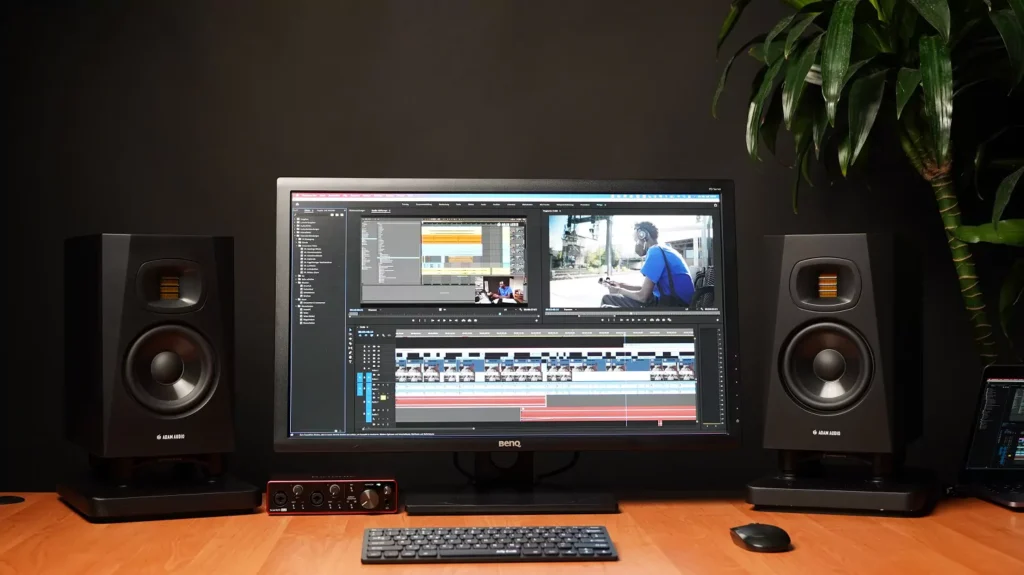As a music producer and studio enthusiast, I’ve always been on the lookout for gear that can take my sound to the next level. That’s why I’m thrilled to dive into the Adam Audio T5V, a studio monitor that’s been causing quite a stir in our community. These compact powerhouses have gained a reputation for delivering impressive audio quality at a price point that won’t break the bank. I’ve spent countless hours testing them out, and I’m eager to share my insights with you.
In this comprehensive review, we’ll explore what makes the Adam Audio T5V stand out in the crowded field of studio monitors. I’ll break down its technical specifications, highlighting the key features that set it apart from the competition. We’ll also compare the T5V to other popular models in its class, giving you a clear picture of how it stacks up. By the end of this article, you’ll have all the information you need to decide if the Adam T5V is the right fit for your studio setup.

Technical Specifications
Let’s dive into the nitty-gritty of the Adam Audio T5V. I’ve spent countless hours testing these monitors, and I’m excited to share the technical details that make them stand out.
Driver Configuration
The T5V boasts a unique driver setup that’s a hallmark of Adam Audio’s design philosophy. At the heart of this monitor is a 5-inch woofer crafted from polypropylene, handling the low to mid-range frequencies. But what really sets it apart is the U-ART tweeter. This isn’t your run-of-the-mill tweeter – it’s a ribbon tweeter that’s capable of reproducing frequencies beyond what our ears can typically hear, up to a staggering 25kHz. This specialized design is a big reason why Adam Audio is known for its crystal clear sound.
Amplification
These monitors are active, meaning each speaker has its own built-in amplifier. The T5V employs Class D amplifiers for both drivers – a 50W amp for the woofer and a 20W amp for the tweeter. This setup ensures each driver gets the power it needs to perform optimally, contributing to the T5V’s impressive sound quality.
Frequency Range
The T5V offers a relatively flat frequency response ranging from 45Hz to 25kHz. Any variation from a flat line is limited to around plus or minus 2dB, which is impressive for monitors in this price range. This flat response makes them well-suited for critical listening and mixing tasks.
Maximum SPL
When it comes to volume, these little powerhouses can really pack a punch. A pair of T5Vs can produce SPLs (Sound Pressure Levels) of up to 106 dB at 1 meter. That’s more than enough for most studio applications, and it ensures you have headroom to spare when you need it.
One thing to note is the rear-ported design. This port helps to extend the bass response, but it also means you’ll need to be mindful of placement in your studio. Overall, the T5V’s technical specifications showcase a well-engineered monitor that punches above its weight class in terms of performance and value.
Key Features
The Adam Audio T5V studio monitors pack a punch with some impressive features that set them apart from the competition. Let’s dive into what makes these speakers stand out.
U-ART Ribbon Tweeter
The heart of the T5V’s high-frequency performance is the U-ART (Unique Accelerated Ribbon Technology) tweeter. This 1.9″ marvel is a game-changer in its price range. Unlike traditional dome tweeters, the U-ART uses a pleated ribbon design. This innovative approach allows it to move air four times more efficiently than conventional designs, resulting in higher sound pressure levels with lower distortion.
I’ve found that this tweeter delivers crystal-clear highs up to 25 kHz, which is pretty impressive for monitors in this class. The clarity and detail in the high end are truly remarkable, allowing me to hear nuances in my mixes that I might have missed otherwise.
HPS Waveguide
Complementing the U-ART tweeter is the HPS (High-frequency Propagation System) waveguide. This precision-engineered component is a key factor in the T5V’s excellent sound dispersion. It creates a wide, uniform sweet spot horizontally while keeping the vertical dispersion tightly focused.
In my experience, this translates to a more forgiving listening position. I’m not glued to one spot in my studio to get an accurate representation of my mix. The imaging remains constant, and I can move around without losing the stereo picture.
DSP-controlled Crossover
Adam Audio has implemented DSP (Digital Signal Processing) technology to manage the crossover between the tweeter and woofer. Set at 3 kHz, this crossover point ensures a seamless transition between the drivers.
I’ve listened carefully, and I can’t detect any inaccuracies at the crossover point. The integration between the low and high frequencies is smooth, contributing to the overall clarity and accuracy of the monitors.
Rear-firing Bass Port
The T5V features a rear-firing bass reflex port, which helps extend the low-frequency response. This design choice allows for a more compact cabinet while still delivering impressive bass performance.
However, it’s worth noting that this rear-port design requires some consideration when placing the monitors in your studio. I’ve found that keeping them at least 16 inches from the wall helps prevent bass build-up. If you need to place them closer, the low filter switch on the back can cut -2dB starting at 300Hz and below, helping to manage any excess bass.

Comparative Analysis
T5V vs. KRK Rokit 5 G4
I’ve spent countless hours comparing these two popular monitors, and the differences are quite interesting. The Adam T5V boasts a brighter sound with exceptional highs, thanks to its ribbon tweeter. On the flip side, the KRK Rokit 5 G4 offers a more balanced sound with a stronger bottom-end.
One key distinction is the bass reflex port placement. The T5V’s rear-firing port might require more careful room placement, while the Rokit 5’s front-facing port is more forgiving. The KRK also comes with more customizable EQ options, which can be handy for fine-tuning.
In terms of mixing, I’ve found the T5V’s mid and high-end boost to be particularly useful. It helps in identifying problematic areas in the mix, especially in the crucial mid and high-mid ranges.
T5V vs. Yamaha HS5
The Yamaha HS5 has long been an industry standard, so how does the T5V stack up? In my experience, both offer premium sound quality, but with some notable differences. The T5V extends lower, reaching down to 45Hz compared to the HS5’s 54Hz. This gives the Adam monitors an edge in reproducing bass frequencies without a subwoofer.
The HS5 has a characteristic boost around 1kHz, which contributes to its famously unforgiving sound. It’s great for highlighting mix issues but can be fatiguing during long sessions. In contrast, I’ve found the T5V to have a smoother mid-range and more detailed highs.
Value for Money
When it comes to bang for your buck, the Adam Audio T5V is hard to beat. They offer performance that rivals pricier models, making them an excellent choice for home studios. While they might not have the ultra-deep bass of larger monitors, their overall balance is impressive.
For beginners or those on a budget, these monitors provide fantastic sound quality and are comfortable for long mixing sessions. Just keep in mind that for bass-heavy genres, you might want to consider adding a subwoofer down the line.
Conclusion
The Adam Audio T5V studio monitors have proven to be a game-changer in the world of affordable yet high-quality audio equipment. Their innovative features, including the U-ART ribbon tweeter and HPS waveguide, deliver exceptional sound clarity and a wide sweet spot. These monitors offer a balanced audio experience, making them suitable for various studio applications, from mixing to critical listening.
For those looking to upgrade their home studio setup, the T5V presents an attractive option. Its competitive pricing, coupled with performance that rivals more expensive models, makes it a smart choice for both beginners and experienced producers. While they may not provide the deepest bass response, their overall sound quality and value for money are hard to beat. In the end, the Adam Audio T5V stands out as a reliable and impressive tool to elevate your audio production game.
FAQs
1. How does the bass performance of the Adam Audio T5V measure up?
The Adam T5V features a 5-inch woofer that enables a bass-frequency response reaching down to 45 Hz.
2. What are the main differences between the Adam T5V and the F5 models?
The T5V tends to have a leaner and brighter sound profile compared to the F5, which offers a richer and fuller sound. Even after adjusting the high-frequency cut switch on the T5V, it remains noticeably brighter than the F5.
3. What is the typical lifespan of studio monitors like the Adam T5V?
Studio monitors generally have a long lifespan, potentially lasting between 10 to 20 years. This duration can be extended by replacing any failing electronic components, such as capacitors, or any disintegrating foam.
4. Is investing in the Adam T5V studio monitors a good decision?
The Adam Audio T5V is highly recommended for those moving from headphones to studio monitors or purchasing their first pair. They provide excellent value and are crucial for achieving accurate sound during music production.
This post may contain affiliate links. If you make a purchase through these links, we may earn a small commission at no additional cost to you.








